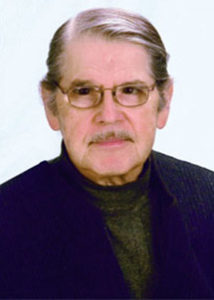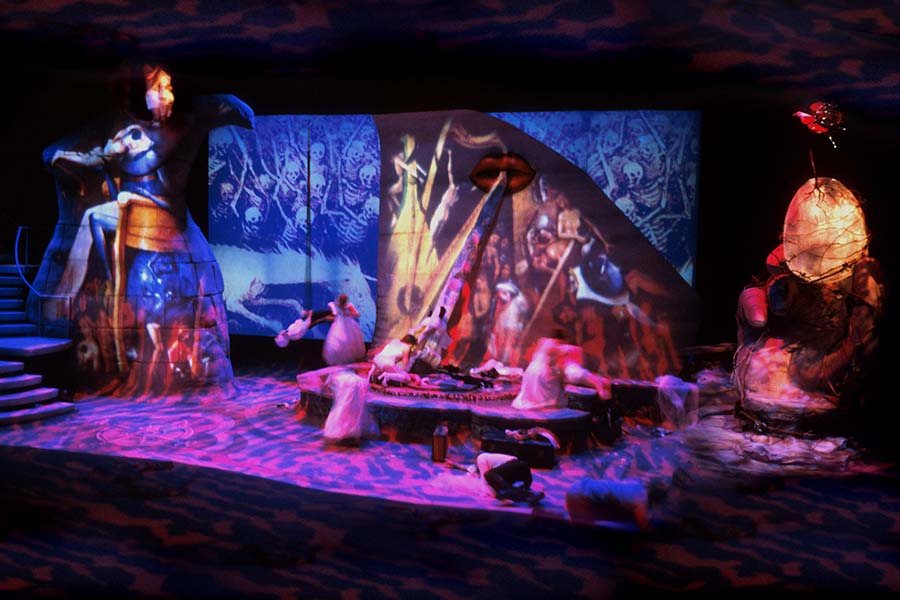Scenic designer and theatremaker Jerry Rojo died on Feb. 27 at his home in Connecticut, close to the University of Connecticut, where he taught for many years. He was 83 and is survived by his son Brian and Joanne Pattavina, who met him at UConn in the mid-1970s, becoming his lifelong partner and soulmate. Pattavina lives in New York City, where she teaches voice for the stage.
Our conversation went like this: “I want something reaching from the floor to the ceiling,” I said. Jerry Rojo (roe-joe) looked over the room full of platforms, its floor covered by used carpets from a remainders store. “How about a spiral of chairs, an inverted tornado spinning up to the ceiling?” “Perfect,” I replied.
After a little pause, he asked, “And the audience? Where will they be?” “Everywhere! They will be all over the place – no separation between the actors and the spectators.”
The time, April 1967. The place, the Players Theatre of Le Petit Theatre du Vieux Carre, a venerable New Orleans institution situated in the French Quarter (of course). The play was the New Orleans Group’s production of Eugene Ionesco’s Victims of Duty. My co-leaders of the New Orleans Group, visual artist Franklin Adams and composer Paul Epstein, had agreed to use the Players “empty”—a black box theatre before there were any.

Rojo had returned for the 1966-67 academic year to Tulane University, where he earned his MFA in 1960, to study with me. Rojo, only seven months younger than I, audited my courses and we became friends. Our work on Victims kicked off a decades-long collaboration after I moved to New York in September 1967. Rojo designed or co-designed such Performance Group productions as Dionysus in 69 (1968), Makbeth: After Shakespeare (1969), the group-devised Commune (1970), Sam Shepard’s The Tooth of Crime (1972), Bertolt Brecht’s Mother Courage and Her Children (1974), and Jean Genet’s The Balcony (1979). Again and again, Rojo reconceived the Performing Garage, starting with a big empty cube and coming up with startlingly new and theatrically just right environments.
Those productions pioneered “environmental theatre,” a style where whole spaces, not just the stage, are totally designed—where the audience and spectators share the space and often interact. Environmental theatre draws on Vsevolod Meyerhold’s and Nikolay Okhlopkov’s work, and, more directly, on Allan Kaprow’s practice and ideas in his Assemblages, Environments, and Happenings (1966). But instead of autonomous happenings, environmental theatre is used in the staging of scripted plays, from classics to contemporary works. Environmental theatre has since morphed into today’s immersive and site-specific performances.
The way Rojo and I worked together was that I would suggest a concept or a problem, and he would respond with concrete solutions. The wave and pueblos of Commune; the wagonless Mother Courage, in which the whole Performing Garage became her wagon, tied together by a network of ropes and pulleys; the bifurcated frontstage/backstage of Tooth of Crime, with the audience clambering back and forth on catwalks from the private side of the room to the public side. We continually made and remade the interior of the Performing Garage.
In The New York Times, Clive Barnes described Rojo’s Makbeth environment this way:
…you walk down a wooden staircase into the playing area itself. This is a wonderful setting. In the center is a flat platform looking like a giant chopping block, and people sit around this as if it were a communal table…Around this are wooden battlements surrounding the walls and linked by steps, platforms and runways. The audience sits, perches and squats while the actors play their scenes in every empty space they can discover. They whirl and whirr their way through this single cube of air occupied only by their wooden castle and us, clinging to it like unseen voyeurs. (New York Times, November 21, 1969)

Jerry Rojo was prodigiously productive from the time he joined UConn in the 1960s until and beyond his becoming professor emeritus in 1990. From 1978 to 1985 he was both the artistic and producing director of UConn’s Nutmeg Theatre (now the Connecticut Repertory Theatre), where he oversaw 70 productions. During the same years, he headed UConn’s Department of Dramatic Arts, leading a staff of 50 on five campuses with programs in acting, directing, design, technical theatre, theatre history, theatre management, puppetry, and environmental theatre. Rojo designed and supervised the construction of the Mobius Theatre, an environmental theatre space currently used as a performance laboratory. Administering big, sprawling, complex programs did not slow Rojo down as an artist.
He designed or co-designed 83 professional productions and 62 UConn productions. He designed or helped renovate 12 theatres. He won a Drama Desk award in 1973 for his design of Samuel Beckett’s Endgame. He shared in the 1968 Obie awarded to the Performance Group for Dionysus in 69. In addition to stage design, Rojo taught acting using this work as the basis of his book, An Acting Method Using the Psychophysical Experience of Workshop Games-Exercises, published in 2000.
At Philadelphia’s Wilma Theater, Rojo designed 12 productions between 1989 and 2004. He was nominated for four Barrymore Awards, winning in 2003 for his design of Charles L. Mee’s Big Love. Wilma artistic director Blanka Zizka writes:
Jerry Rojo was a very special artist: always curious, always ready to learn, even though he himself had an encyclopedic knowledge of theatre…Jerry had an uncanny ability to reach into the core of a play to release the energies of the text and allow them to resonate in the environment he created…He was much more than a set designer: He was a true collaborator and visionary. More than anything, he was one of the kindest, most caring human beings.
But all this does not fully or truly express who Jerry Rojo was, and will continue to be in the lives and works of those who knew him. He was born near Chicago, where his parents, Guadalupe and Dorothy, both worked at Abbott Laboratories. His father was on the team that helped invent the manufacturing process for penicillin. Rojo’s father was an inventor with several patents. While Jerry was a child, his dad was in the basement each night working on various inventions. Curiosity and creativity were part of the family package.
Rojo was not a physically large man. He was sturdy, broad-shouldered, strong. He loved working with his hands, going in there and getting the job done. He wore thick glasses, but saw far beyond what eyes could envision. Like his father, he was an inventor. He was warm-hearted, always willing to accept a challenge, to take on one more thing to help a student, a former student, or a colleague. What’s more, Rojo produced—his promises were not empty. If he said he’d do something, you could consider it done. Jerry Rojo was that rare human being: a good friend, a significant artist, a first-rate teacher, an honest and reliable administrator, an affectionate soulmate, and a caring father. I will miss him. And I am among a multitude.
Richard Schechner is University Professor Emeritus at the Tisch School of the Arts, New York University, and editor of TDR: The Drama Review.





